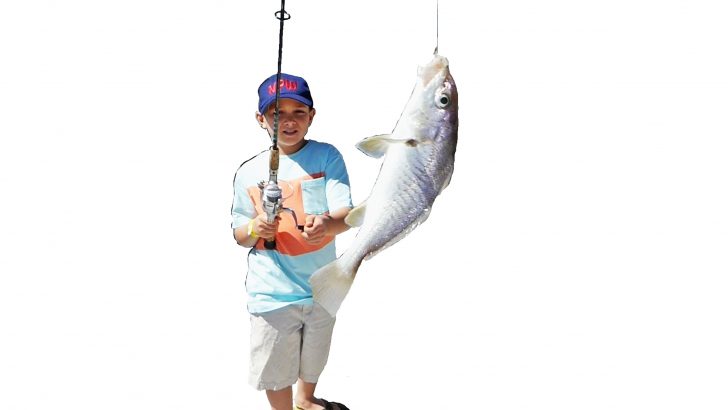When it comes to sport fishing, or fishing in general, there have always been a few expectations that anglers look for. One, always trying to catch the largest fish.
When it comes to tips, tricks and information that could help them reach their goals while fishing, it all seems to point to the adult fisherman.
I have written a number of articles and made videos that do just that. But, there is a saying, and I am sure most of us have heard it before, it’s the small things that count.
The reason I am bringing up this old statement is because I believe that it can be applied by today’s fishermen.
The first small thing that counts that comes to mind are today’s children.
After all, they can be the future fishermen of tomorrow, if given the chance, and the equation is quite simple.
A small child + a small fishing pole + a small rig + small bait = small fish + a humongous smile that will last a lifetime.
So, in this article, I am going to explain a short but sweet fishing technique for the children.
So that mom, dad, grandparents, an uncle or aunt or a family friend can take a child inshore fishing.
The can hopefully, have a great time and maybe even create a future angler.
For starters, you will need a small fishing rod. The most popular style that is commonly used for small children is a spincast reel and rod, or otherwise known as a push-button.
The reel will need to have at least 8- to 10-pound test monofilament line. The rig you would be using is a Carolina rig, but the rig will be small.
You will need some half-ounce egg weights, small 10 to 20 pound test swivels, a 25-yard spool or more of 10-pound test fluorocarbon leader line.
A pack of Octopus-style fishing hooks in size 6 or 8 and some fresh or frozen Shrimp for bait.
The reason I suggest Shrimp is because Shrimp is considered one of the best catch-all baits when fishing inshore. Everything seems to want to eat them.
For those of you who are not familiar with how to assemble a Carolina rig, I will explain.
After lacing your fishing line, referred to as the fight line, through the guides of the fishing rod, you will then take the fight line and stick it through your egg weight.
Then take the end of your fight line and tie it to one side of the swivel, using whatever fishing knot, you are capable of tying.
Now you will take your 10-pound fluorocarbon and cut a piece off approximately 14 inches long. Take the piece of fluorocarbon and tie one end to the other side of the swivel.
Then you will take the other side of the fluorocarbon and tie it to your small fishing hook.
After tying your knots, your leader line from your swivel to your hook will average around 11 inches or slightly longer, and now you have your Carolina rig.
The trick now is the Shrimp. Baiting the Shrimp is very important.
If the Shrimp is not placed on the hook correctly, you may find yourself going through a lot of bait, receiving a lot of bites, and hooking no fish.
This can become frustrating for both the adult and the child. Of course, not all fishing trips will end up successful.
There are other things to look for and location is one of them. After all, if there are no fish, there will be no catching.
The first thing you would need to do with the Shrimp is to peel the shell off.
Then you lay the piece of Shrimp down sideways on a cutting board and cut the Shrimp in quarter-inch pieces.
Then you will take one of the quarter-inch pieces and bait your hook with it.
Just remember, when pushing the hook through the small piece of Shrimp, you want to go through the side of the Shrimp.
This is because the grain of the flesh of the Shrimp runs from the tail to the head, and when placing the hook in that direction, that will cause the bait to separate and just fall off the hook.
Shrimp is soft enough as it is, and it will not take much for one of the small fish to steal it right from the hook.
I will let you in on one small trick. Sometimes I like to take my Shrimp, cut it up like described above, and then sit it on my cutting board in the sun.
Before you know it, the sun starts to dry out the Shrimp slightly, and as the Shrimp dries out, it becomes harder.
Therefore, allowing it to stay on the hook for longer periods of time, and even making it harder for the small fish to steal it.
The only thing left to know now would be a technique used to catch these fast, small critters, like Pinfish, Croaker, Whiting, Spot and Toadfish.
Don’t be surprised if the child accidently hooks into larger game fish like Black Drum, Spotted Seatrout and even Red Drum.
I have seen this happen more than once in my lifetime.
The trick is to drop the line out into the water, and once the line hits the bottom, tighten the line so that there is no slack left in it.
Encourage the child to watch his or her line, anticipating a bite.
When you see the line bounce or the rod tip, do not have the child set the hook immediately.
Instead, have the child slowly lower the tip of his or her rod, leaning into the fish.
This allows the fish, when vacuuming in the bait, to take in the hook as well.
As you notice the line start to walk away, then pull back and set the hook. The rest is a show—a child in glee and a smile on both of your faces!
I hope this helps you and a child during your first or next fishing adventure, and remember, it’s the small things that count!
Like I always say, until next time, good luck out there and have fun fishing!
To view some fishing adventures, go to my YouTube Channel Fishing With Jiggin Jerry.
LEAVE COMMENTS AT THE BOTTOM!
You may also enjoy reading Artificial Intelligence ~ Threading The Needle
Click the picture to go to our website!







